Just like a website that needs constant updates, your mobile app thrives on regular maintenance. This keeps your app functioning smoothly and securely.
App maintenance involves finding bugs that crash the app or can negatively affect it in the long run. A web app development company offering these services will optimize the code to run efficiently on all devices, ensuring fast loading times and a responsive experience.
Further, security is a must in digital solutions. So maintenance also includes fixing issues that could expose user data. New features can be integrated based on user feedback and industry trends while keeping your app compatible with the latest Android and iOS versions to ensure everyone can enjoy it. Ignoring maintenance can lead to a technical mess: bugs multiplying, security risks increasing, and compatibility issues alienating users. So check out this blog below to know more about app maintenance services.
What is App Maintenance?
Any app needs continuous maintenance to ensure things run smoothly and keep users happy. App maintenance is all about updates to keep your app in line with the latest trends for apps, squashing bugs that might cause crashes, and adding new features that users will love.
It’s like taking care of your app – the more you do it, the longer it stays functional. So whether you are working with an Android or an iOS development company, do not forget to inquire about the maintenance services they offer.
Why Should You Go for App Maintenance?
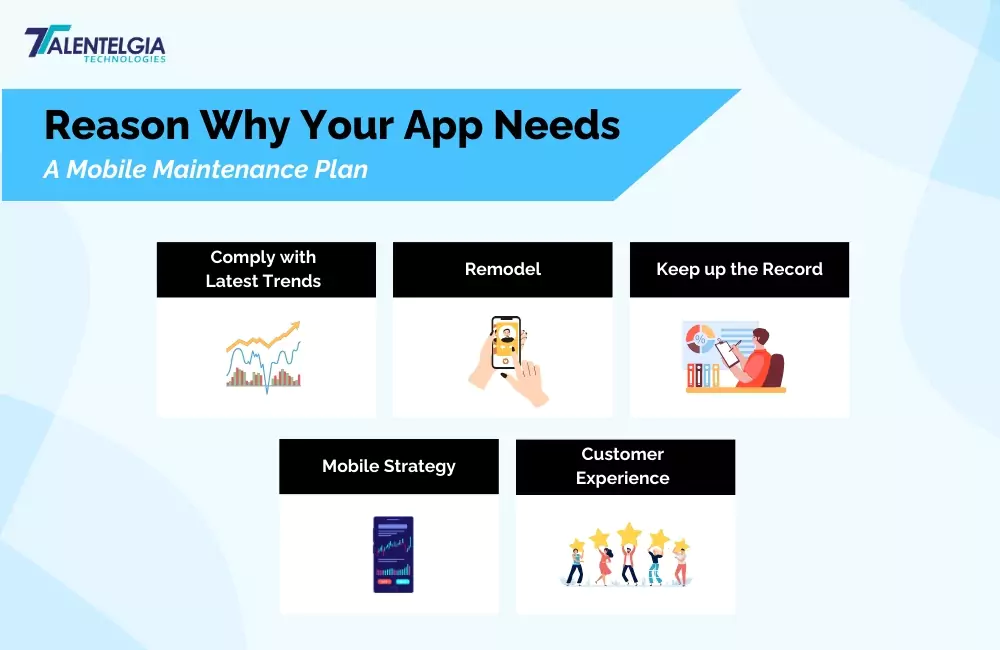
How Much Does App Maintenance Cost?
The cost of maintenance varies based on your app’s complexity and update frequency. A well-maintained app avoids pitfalls, keeping users happy and engaged. To manage costs, focus on fixing the most critical bugs first, utilize automated testing tools, write clean and modular code for easier updates, and keep third-party libraries you rely on up-to-date. By prioritizing maintenance, you ensure your app stays technically sound and continues to deliver value to your users.
App Complexity
Simple applications with simple functions, such as a calculator or a simple news reader, are often cheaper to maintain due to their limited functionality and simple code.
In contrast, managing complex applications such as social media platforms or e-commerce apps requires more support and effort. These applications often include advanced features such as user accounts, complex data, and real-time updates, all of which increase maintenance costs. Small applications with limited screens and data storage are easier and cheaper to manage.
Mobile App Maintenance Cost Breakdown
| Expenses | Cost per month |
| Servers | $20-$60 |
| Push Notification | $10 |
| Payment Gateway | $149 (depends on % of each commission) |
| Type of Maintenance | It depends on the emergency ($50 upwards) |
| App Store Fee | $25-Google play, $99-Apple App |
App Features
Large applications with large screens and extensive data storage (such as applications with large content or video) need more support for updates and maintenance, leading to higher costs. Applications that do not rely on external services are easier to manage.
For example, indie games that don’t have social media or payment integrations are easier to manage. However, apps that use third-party services such as payment gateways, social media logins, or service providers need regular updates to ensure compatibility and security. These integrations require constant monitoring and updating, which increases the cost of maintenance.
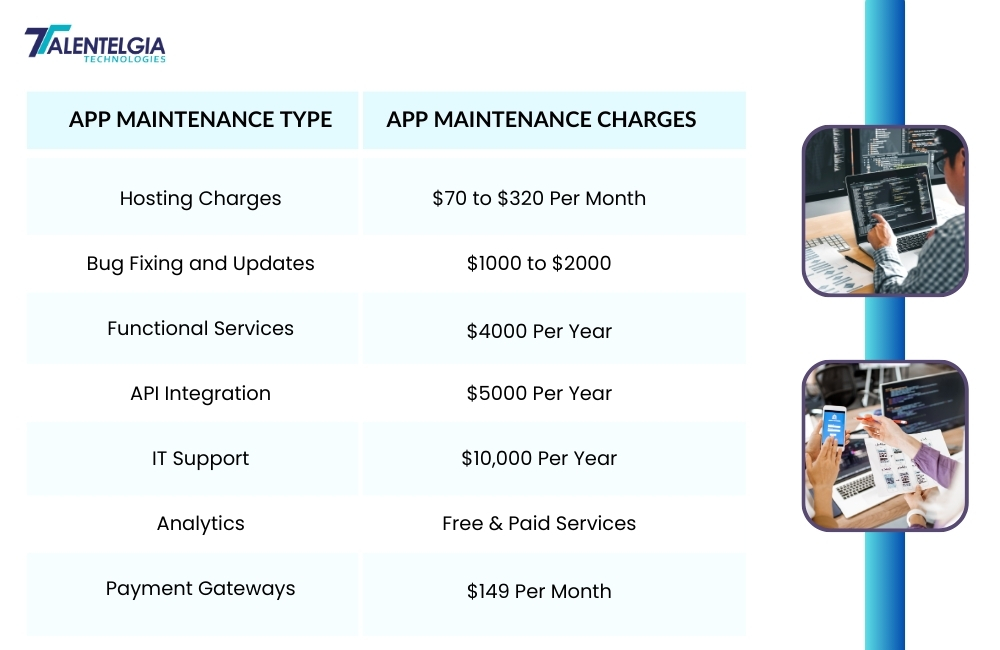
Android vs iOS Applications
It is easier and cheaper to maintain an app developed for a single platform, such as iOS or Android only. However, if an app needs to run on both iOS and Android, maintenance costs will be higher. Each platform has its own operating system, product requirements, and development processes that require more time and effort to manage. Applications with large user bases and high traffic require additional resources to manage load, monitor performance, and troubleshoot problems.
User Collaboration
Collaboration with more users requires more frequent updates and improved features, which means higher maintenance costs. By considering these factors, application owners can estimate maintenance costs and plan their budgets effectively. Understanding your application’s unique needs and requirements is critical to improving maintenance processes and reducing costs.
Cost Analysis
App maintenance generally ranges between 15% – 20% of the total cost. Factors such as mobile app hosting costs, technology implemented, location, server maintenance costs, features of the app, and mobile app development company can influence the maintenance cost. On average, app owners need to secure $250 -$500 per month for maintenance to keep the app running perfectly. The cost may vary based on the location of the app developers and the type of maintenance required.
Country Wise App Maintenance Cost Breakdown
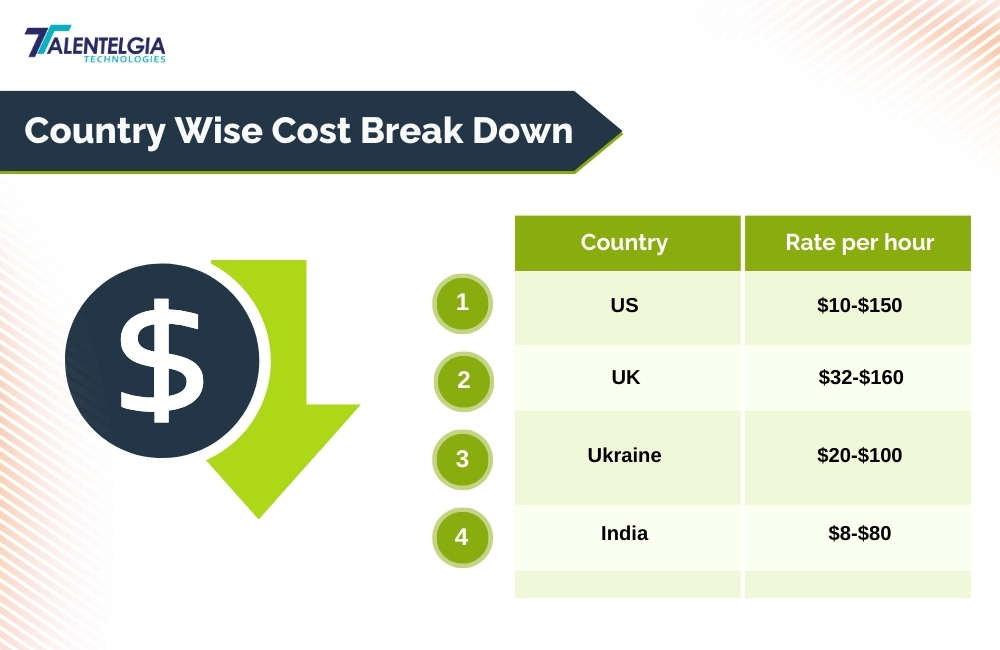
Factors Affecting App Maintenance Cost
How much you pay when working with an app development company depends on several factors. These include app complexity, features, technology stack, platform, design, developer location, and maintenance needs. Understanding these factors can help accurately estimate the total cost and avoid overspending.
1. App Complexity: Maintenance costs are often higher for complex apps. Apps with intricate features and functionalities demand more resources and effort for updates and upkeep, while simpler apps with basic functions have lower maintenance costs.
2. App Size: The size of an app, including the number of screens, data storage requirements, and content volume, significantly impacts maintenance costs. Larger apps with extensive data storage and more screens require more resources for regular updates and maintenance.
3. Third-Party Integrations: Apps that use third-party services, such as payment gateways, social media APIs, or location services, tend to have higher maintenance costs. These integrations often need updates and compatibility checks to ensure smooth operation and security.
4. Platform Compatibility: Supporting multiple platforms, like iOS and Android, can increase maintenance costs. Each platform has different operating systems, device requirements, and development guidelines, which require additional time and effort to manage.
5. User Base and Traffic: The number of users and the level of traffic an app experiences also affect maintenance costs. Apps with a large user base and high traffic need more resources to manage the increased load, monitor performance, and resolve issues.
5 Tips to Reduce Mobile App Maintenance Cost
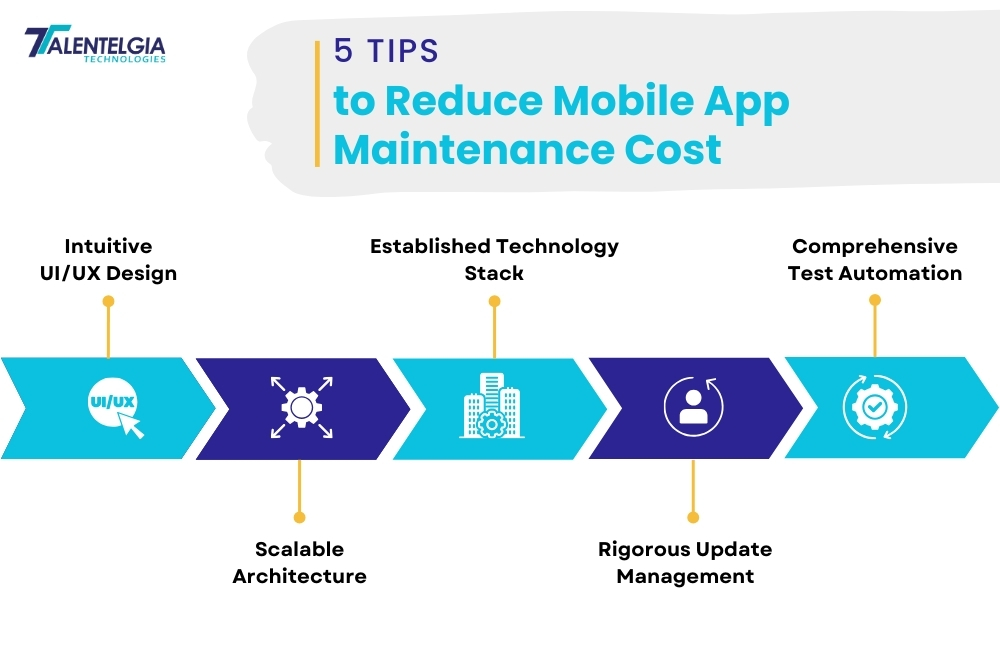
1. Intuitive UI/UX Design: Prioritize UI & UX design to minimize future updates. A well-designed app boasts intuitive navigation, reducing bug occurrences and development effort for maintenance. This helps in lowering long-term costs.
2. Scalable Architecture: Implement a flexible architecture that allows for seamless feature expansion and updates. This reduces the need for a complete makeover, ensuring efficient adaptation to evolving user requirements. Imagine a modular system where components can be added or modified without affecting the core structure.
3. Established Technology Stack: Use well-supported and widely adopted technologies for app development. This simplifies maintenance tasks as readily available resources and established support channels minimize troubleshooting time and development costs. Additionally, these technologies often come with built-in features and debugging tools, further reducing the need for custom solutions and unforeseen complications.
4. Rigorous Update Management: Regularly update all third-party libraries and frameworks integrated into your app. Outdated components pose security vulnerabilities and performance issues. A proactive update strategy ensures a robust and secure app, preventing costly downtime and potential data breaches.
5. Comprehensive Test Automation: Implement a robust automation test suite to thoroughly evaluate app functionality throughout development. Early bug detection prevents them from escalating into major issues later. This proactive approach streamlines the development process and minimizes post-release bug fixes, leading to significant cost savings.
Best Practices for Effective App Maintenance
App maintenance includes regular updates, bug fixes, performance monitoring, security improvements, and user feedback. Best practices such as regular maintenance schedules, proactive bug tracking, and user engagement can help ensure the long-term success of your application.
- Back up app data and codes regularly to prevent loss or damage.
- Carefully test updated applications before deploying to ensure compatibility and stability.
- Track user feedback and comments to identify areas for improvement and prioritize projects.
- Use analytics to gather insights about user behavior, performance, and app usage to identify areas that need attention and inform maintenance decisions.
Frequently Asked Question (FAQs)
How can I estimate the long-term maintenance costs of my app?
Long-term maintenance cost estimation involves considering factors such as the app’s complexity, expected user base growth, technology advancements, and potential regulatory changes. Detailed planning, periodic reviews, and adjusting budgets based on evolving needs can facilitate more accurate estimations.
Do app maintenance costs vary depending on the platform (iOS, Android, web)?
Yes, keeping apps up-to-date costs differently for each. iOS apps may need updates to meet Apple’s rules and new iOS versions, while Android apps may need fixes for different device types and Android versions. Web apps also need work to fit various web browsers and for security.
How frequently should app maintenance tasks be performed to ensure optimal performance?
It’s important to work on your app regularly to keep it working its best. How often you do this depends on user feedback, new technology, security worries, and changes in how the app is used. Normally, it’s good to check, update, and make your app faster often to keep users happy.
Conclusion
Just like your favorite gadgets need to be serviced periodically to work optimally, your mobile apps need regular maintenance to thrive. This ensures everything runs smoothly and customers are happy. The important thing is to ensure your app complies with the latest app guidelines, remove bugs that can cause crashes, and add new features that users will love. Security is also a big concern; monitoring can make your applications safe from online threats. Remember, your application needs maintenance to keep it running smoothly over time. By paying attention to priorities, you invest in the future of your application.


 Healthcare App Development Services
Healthcare App Development Services
 Real Estate Web Development Services
Real Estate Web Development Services
 E-Commerce App Development Services
E-Commerce App Development Services E-Commerce Web Development Services
E-Commerce Web Development Services Blockchain E-commerce Development Company
Blockchain E-commerce Development Company
 Fintech App Development Services
Fintech App Development Services Fintech Web Development
Fintech Web Development Blockchain Fintech Development Company
Blockchain Fintech Development Company
 E-Learning App Development Services
E-Learning App Development Services
 Restaurant App Development Company
Restaurant App Development Company
 Mobile Game Development Company
Mobile Game Development Company
 Travel App Development Company
Travel App Development Company
 Automotive Web Design
Automotive Web Design
 AI Traffic Management System
AI Traffic Management System
 AI Inventory Management Software
AI Inventory Management Software
 AI Software Development
AI Software Development  AI Development Company
AI Development Company  AI App Development Services
AI App Development Services  ChatGPT integration services
ChatGPT integration services  AI Integration Services
AI Integration Services  Generative AI Development Services
Generative AI Development Services  Natural Language Processing Company
Natural Language Processing Company Machine Learning Development
Machine Learning Development  Machine learning consulting services
Machine learning consulting services  Blockchain Development
Blockchain Development  Blockchain Software Development
Blockchain Software Development  Smart Contract Development Company
Smart Contract Development Company  NFT Marketplace Development Services
NFT Marketplace Development Services  Asset Tokenization Company
Asset Tokenization Company DeFi Wallet Development Company
DeFi Wallet Development Company Mobile App Development
Mobile App Development  IOS App Development
IOS App Development  Android App Development
Android App Development  Cross-Platform App Development
Cross-Platform App Development  Augmented Reality (AR) App Development
Augmented Reality (AR) App Development  Virtual Reality (VR) App Development
Virtual Reality (VR) App Development  Web App Development
Web App Development  SaaS App Development
SaaS App Development Flutter
Flutter  React Native
React Native  Swift (IOS)
Swift (IOS)  Kotlin (Android)
Kotlin (Android)  Mean Stack Development
Mean Stack Development  AngularJS Development
AngularJS Development  MongoDB Development
MongoDB Development  Nodejs Development
Nodejs Development  Database Development
Database Development Ruby on Rails Development
Ruby on Rails Development Expressjs Development
Expressjs Development  Full Stack Development
Full Stack Development  Web Development Services
Web Development Services  Laravel Development
Laravel Development  LAMP Development
LAMP Development  Custom PHP Development
Custom PHP Development  .Net Development
.Net Development  User Experience Design Services
User Experience Design Services  User Interface Design Services
User Interface Design Services  Automated Testing
Automated Testing  Manual Testing
Manual Testing  Digital Marketing Services
Digital Marketing Services 
 Ride-Sharing And Taxi Services
Ride-Sharing And Taxi Services Food Delivery Services
Food Delivery Services Grocery Delivery Services
Grocery Delivery Services Transportation And Logistics
Transportation And Logistics Car Wash App
Car Wash App Home Services App
Home Services App ERP Development Services
ERP Development Services CMS Development Services
CMS Development Services LMS Development
LMS Development CRM Development
CRM Development DevOps Development Services
DevOps Development Services AI Business Solutions
AI Business Solutions AI Cloud Solutions
AI Cloud Solutions AI Chatbot Development
AI Chatbot Development API Development
API Development Blockchain Product Development
Blockchain Product Development Cryptocurrency Wallet Development
Cryptocurrency Wallet Development About Talentelgia
About Talentelgia  Our Team
Our Team  Our Culture
Our Culture 
 Healthcare App Development Services
Healthcare App Development Services Real Estate Web Development Services
Real Estate Web Development Services E-Commerce App Development Services
E-Commerce App Development Services E-Commerce Web Development Services
E-Commerce Web Development Services Blockchain E-commerce
Development Company
Blockchain E-commerce
Development Company Fintech App Development Services
Fintech App Development Services Finance Web Development
Finance Web Development Blockchain Fintech
Development Company
Blockchain Fintech
Development Company E-Learning App Development Services
E-Learning App Development Services Restaurant App Development Company
Restaurant App Development Company Mobile Game Development Company
Mobile Game Development Company Travel App Development Company
Travel App Development Company Automotive Web Design
Automotive Web Design AI Traffic Management System
AI Traffic Management System AI Inventory Management Software
AI Inventory Management Software AI Software Development
AI Software Development AI Development Company
AI Development Company ChatGPT integration services
ChatGPT integration services AI Integration Services
AI Integration Services Machine Learning Development
Machine Learning Development Machine learning consulting services
Machine learning consulting services Blockchain Development
Blockchain Development Blockchain Software Development
Blockchain Software Development Smart contract development company
Smart contract development company NFT marketplace development services
NFT marketplace development services IOS App Development
IOS App Development Android App Development
Android App Development Cross-Platform App Development
Cross-Platform App Development Augmented Reality (AR) App
Development
Augmented Reality (AR) App
Development Virtual Reality (VR) App Development
Virtual Reality (VR) App Development Web App Development
Web App Development Flutter
Flutter React
Native
React
Native Swift
(IOS)
Swift
(IOS) Kotlin (Android)
Kotlin (Android) MEAN Stack Development
MEAN Stack Development AngularJS Development
AngularJS Development MongoDB Development
MongoDB Development Nodejs Development
Nodejs Development Database development services
Database development services Ruby on Rails Development services
Ruby on Rails Development services Expressjs Development
Expressjs Development Full Stack Development
Full Stack Development Web Development Services
Web Development Services Laravel Development
Laravel Development LAMP
Development
LAMP
Development Custom PHP Development
Custom PHP Development User Experience Design Services
User Experience Design Services User Interface Design Services
User Interface Design Services Automated Testing
Automated Testing Manual
Testing
Manual
Testing About Talentelgia
About Talentelgia Our Team
Our Team Our Culture
Our Culture
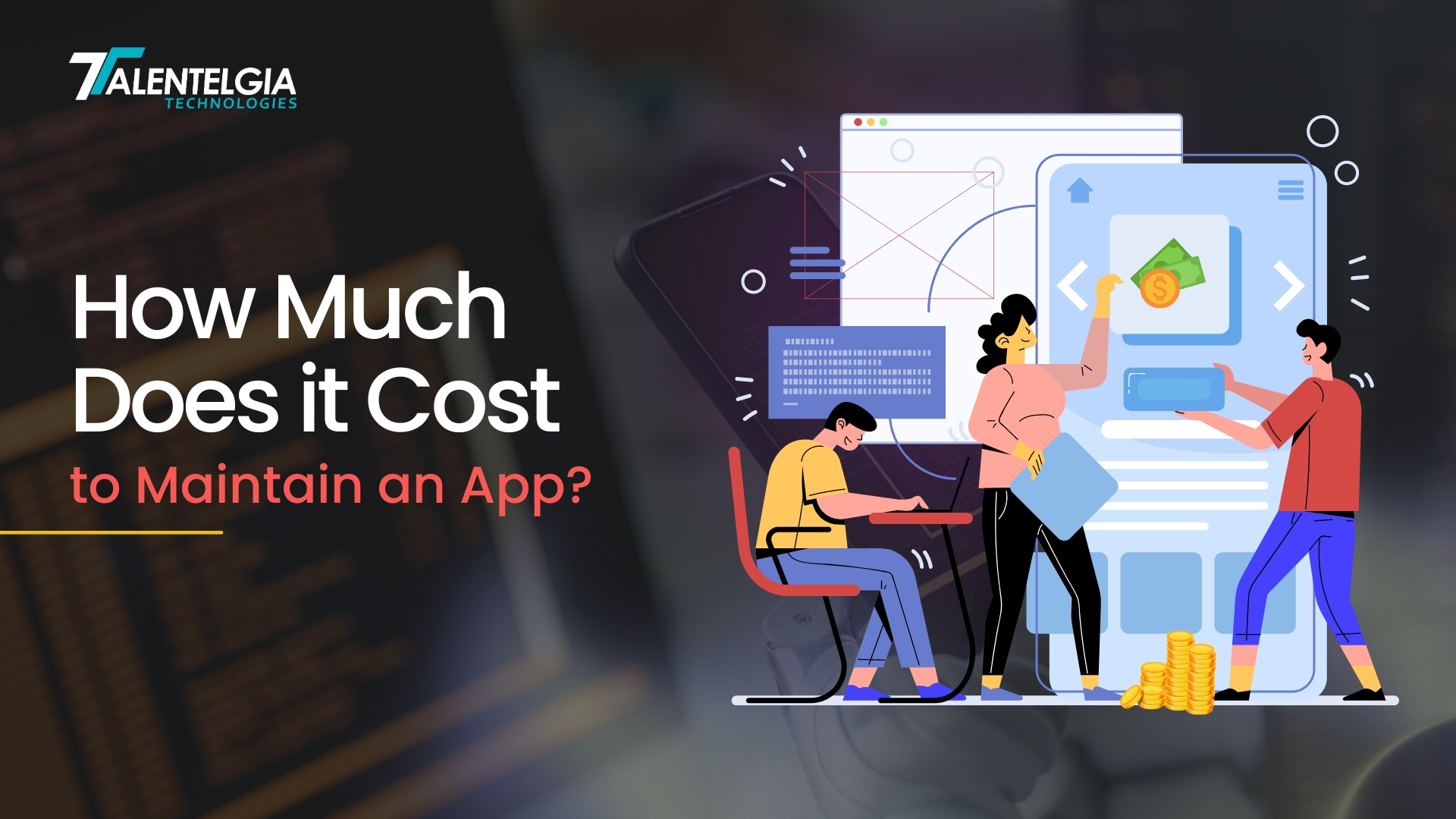
















 Write us on:
Write us on:  Business queries:
Business queries:  HR:
HR: 




